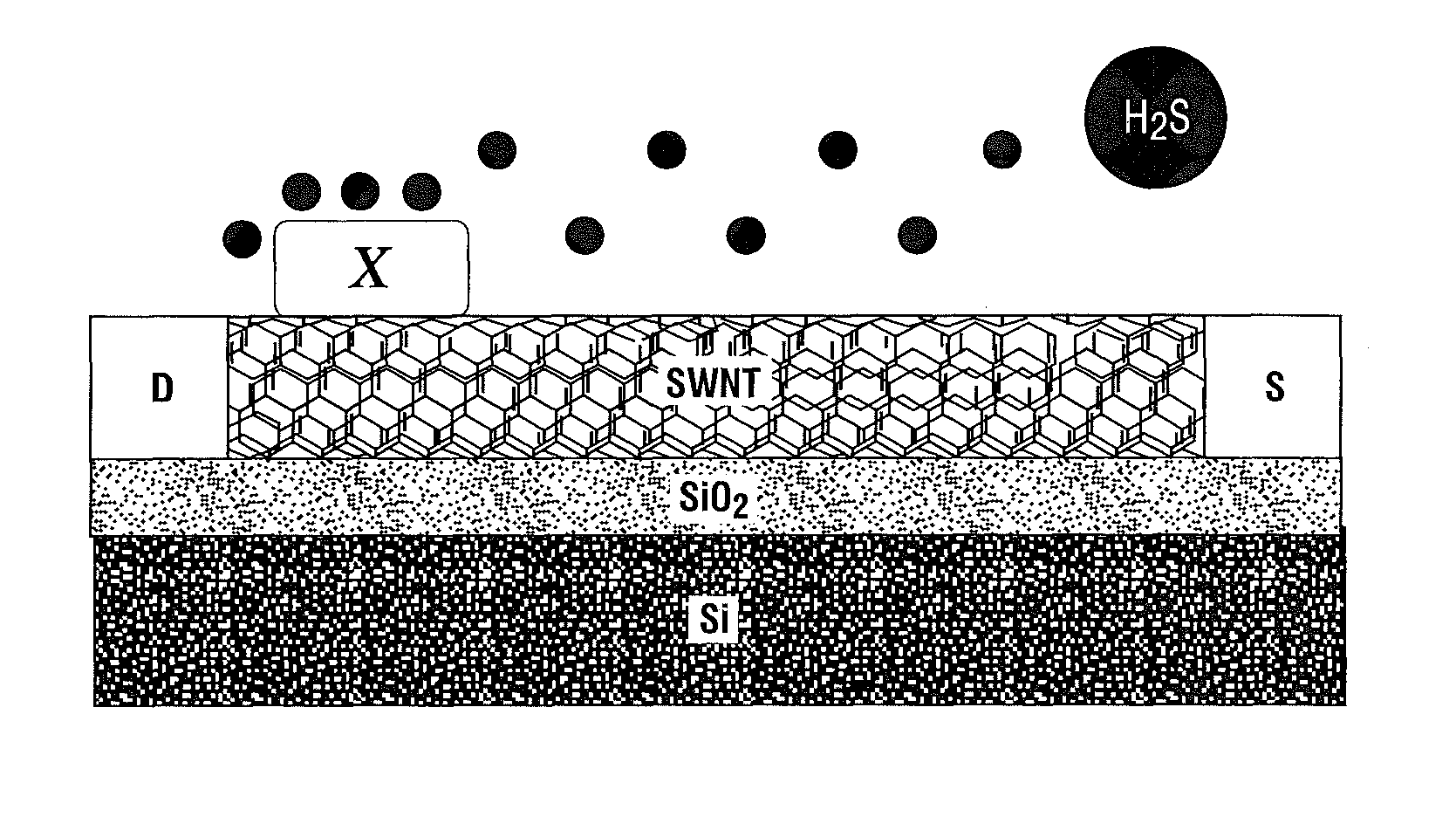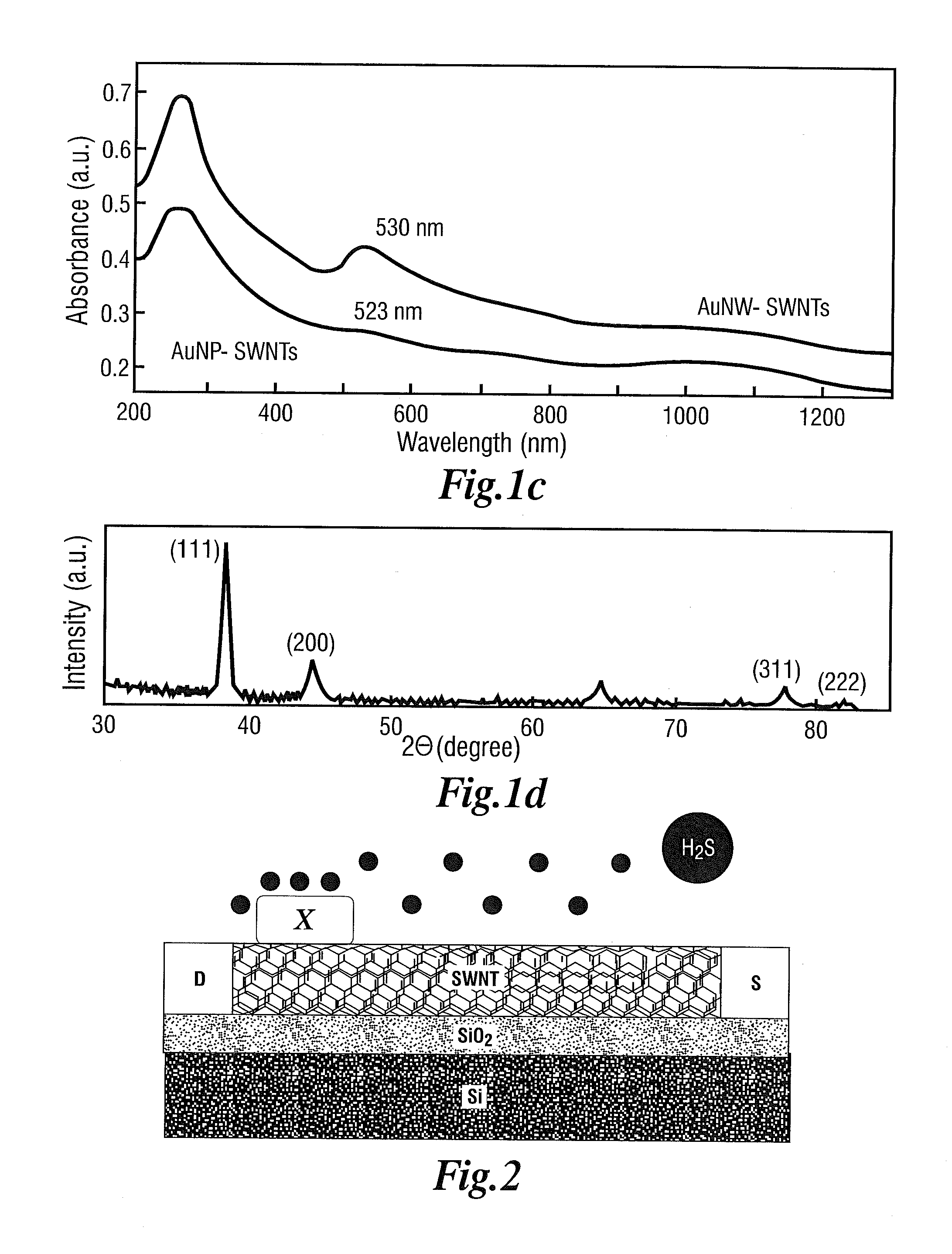Detection of hydrogen sulfide gas using carbon nanotube-based chemical sensors
a carbon nanotube and chemical sensor technology, applied in the field of detection of hydrogen sulfide gas using carbon nanotube-based chemical sensors, can solve the problems of limited chemical stability of pani-nanofibers, hydrogen sulfide can affect personal and social communication, and hydrogen sulfide can induce significant hydrogen sulfide sensitivity, high sensitivity and portability
- Summary
- Abstract
- Description
- Claims
- Application Information
AI Technical Summary
Benefits of technology
Problems solved by technology
Method used
Image
Examples
example 1
“X”=Gold Nanowires (AuNW)
[0059]Gold nanowire functionalized SWNTs of a preferred embodiment of the present invention were synthesized by first functionalizing single-walled carbon nanotubes with 1-pyrenesulfonic acid (PSA) to produce a uniform aqueous suspension, and then citrate reduction of chloroauric acid in the single-walled carbon nanotube suspension. In this preferred embodiment, the citrate reduction was done in situ.
[0060]Gold nanowire morphology was found to be very important for hydrogen sulfide detection. Compared to SWNT functionalized with gold nanoparticles by electrodeposition (gold nanoparticle-SWNT), gold nanowire-SWNT showed better response (which is a decrease in conductivity) when exposed to hydrogen sulfide at the concentration range from 10 ppb to 40 ppm (diluted in nitrogen). FIG. 8 illustrates the method for preparation of gold-nanowire functionalized nanotubes and the difference in response between gold-nanowire functionalized nanotubes and gold-nanoparticl...
example 2
“X”=Polyaniline (PAni) Coatings With Additional Metal Salt Doping
[0063]SWNT / PAni composite of a preferred embodiment of the present invention was synthesized by aniline polymerization in SWNTs suspension. SWNTs were functionalized with 1-pyrenesulfonic acid (PSA) prior to the polymerization as illustrated in FIG. 9a.
[0064]TEM and atomic force microscopy (AFM) of SWNT / PAni composite revealed the SWNTs had a uniform PAni coating (FIG. 9b). The PAni coating was further confirmed by Fourier transform infrared (FTIR) spectroscopy (FIG. 9c), where SWNT / PAni composite showed typical absorption peaks at 1512, 1585 and 3263 cm-1. These bands were associated with stretching of benzenoid and quinoid rings as well as N—H stretching of benzenoid amine groups of PAni, respectively. Thermogravimetric analysis (FIG. 9d) confirmed that the ratio of PAni to SWNT was about 1:1 (wt), as the SWNT / PAni composite showed 50% mass loss from 200 to 800° C. This loss was attributed to the decomposition of PA...
PUM
| Property | Measurement | Unit |
|---|---|---|
| Electrical conductance | aaaaa | aaaaa |
| Sensitivity | aaaaa | aaaaa |
Abstract
Description
Claims
Application Information
 Login to View More
Login to View More - R&D
- Intellectual Property
- Life Sciences
- Materials
- Tech Scout
- Unparalleled Data Quality
- Higher Quality Content
- 60% Fewer Hallucinations
Browse by: Latest US Patents, China's latest patents, Technical Efficacy Thesaurus, Application Domain, Technology Topic, Popular Technical Reports.
© 2025 PatSnap. All rights reserved.Legal|Privacy policy|Modern Slavery Act Transparency Statement|Sitemap|About US| Contact US: help@patsnap.com



